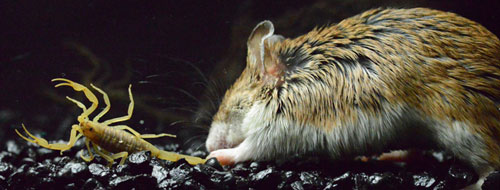Grasshopper Mice have Evolved Neurons that Block the Painful Sting of the Bark Scorpion

Contacts: Lee Clippard; clippard@austin.utexas.edu; 512-232-0675
Ashlee Rowe; roweashl@msu.edu; 517-432-4468
Austin, TEXAS—Bark scorpions are well known for inflicting intensely painful, potentially lethal stings. But grasshopper mice respond to the bark scorpion’s sting by grooming for only a few seconds before pressing their attack, voraciously killing and consuming the scorpion. How the mouse manages to defend itself from the painful venom of its scorpion prey is detailed this week in the journal Science.
The study, conducted at The University of Texas at Austin, was led by Ashlee Rowe in the laboratory of Professor of Neuroscience Harold Zakon, who is also an adjunct scientist at the Marine Biological Laboratory (MBL) in Woods Hole, Mass.
Rowe and Zakon are interested in the function and evolution of ion channels, proteins in cell membranes that act as channels for charged ions to pass into and out of the cell.
Rowe and Zakon discovered that the bark scorpion toxin, rather than eliciting a pain response in the grasshopper mouse, instead acts as an analgesic by binding to sodium channels in the mouse’s pain neurons. This blocks the neurons from firing a pain signal to the brain.
 The grasshopper mouse and its prey, the bark scorpion. Credit: University of Texas at Austin
The grasshopper mouse and its prey, the bark scorpion. Credit: University of Texas at Austin“This [toxin] kills other mammals of similar size,” said Rowe, who is now a Michigan State University assistant professor of neuroscience and zoology. “The grasshopper mouse has developed the evolutionary equivalent of martial arts to use the scorpions’ greatest strength against them.”
To test whether the grasshopper mice felt pain from the toxin, the scientists injected small amounts of scorpion venom or nontoxic saline solution in the mice’s paws. Surprisingly, the mice licked their paws (a typical toxin response) much less when injected with the scorpion toxin than when injected with a nontoxic saline solution.
“This seemed completely ridiculous,” said Zakon. “One would think that the venom would at least cause a little more pain than the saline solution. This would mean that perhaps the toxin plays a role as an analgesic. This seemed very far out, but we wanted to test it anyway.”
Pain neurons have a couple of different sodium channels, called 1.7 and 1.8, and research has shown that when toxins bind to 1.7 channels, the channels open, sodium flows in and the pain neuron fires.
By sequencing the genes for both the 1.7 and 1.8 sodium channels, the scientists discovered that channel 1.8 in the grasshopper mice has amino acids different from mammals that are sensitive to bark scorpion stings, such as house mice, rats and humans. They then found that the scorpion toxin binds to one of these amino acids to block the activation of channel 1.8 and thus inhibit the pain response.
“Incredibly, there is one amino acid substitution that can totally alter the behavior of the toxin and block the channel,” said Zakon.
The riddle hasn’t been completely solved just yet, though, Rowe said.
“We know the region of the channel where this is taking place and the amino acids involved,” she said. “But there’s something else that’s playing a role, and that’s what I’m focusing on next.”
Some resistance to prey toxins in mammals has been found in other species. The mongoose, for example, is resistant to the cobra. And naked mole rats’ eyes do not burn in pain when carbon dioxide builds up in their underground tunnels.
This study, however, is the first to find that an amino acid substitution in sodium channel 1.8 can have an analgesic effect.
Rowe said studies such as this could someday help researchers target these sodium channels for the development of analgesic medications for humans.
Additional researchers contributing to this study include: Yucheng Xiao, associate faculty member, and Ted Cummins, professor of pharmacology and toxicology, at the Indiana University School of Medicine; Matthew Rowe, professor of zoology at Michigan State University. Zakon is an adjunct scientist in the MBL’s Josephine Bay Paul Center for Comparative Molecular Biology and Evolution.
Video: http://youtu.be/3S4sMBFBZ0M
Citation:
Rowe AH, Xiao Y, Rowe MP, Cummins TR, and Zakon HH (2013) Voltage-Gated Sodium Channel in Grasshopper Mice Defends Against Bark Scorpion Toxin. Science 342: 441-446 DOI: 10.1126/science.1236451
This release was adapted from materials provided by the University of Texas at Austin.
###
The Marine Biological Laboratory (MBL) is dedicated to scientific discovery and improving the human condition through research and education in biology, biomedicine, and environmental science. Founded in Woods Hole, Massachusetts, in 1888, the MBL is a private, nonprofit institution and an affiliate of the University of Chicago.